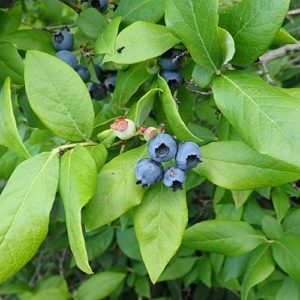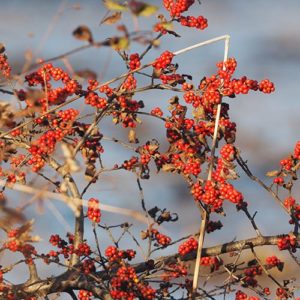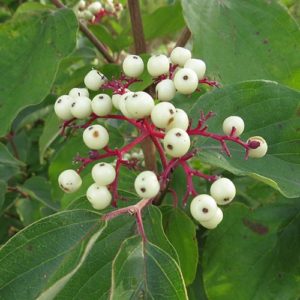Planting native trees and shrubs that produce berries is a great way to attract songbirds to your yard. Many of our songbirds rely on berries and other berry-like fruits for at least part of their diet. Some of our migratory songbirds, like gray catbirds, consume a significant amount of fruit, especially during their fall migration. In addition, many of our year-round residents such as cardinals and chickadees will eat berries especially in the late fall and winter when seeds and insects aren’t as abundant.

Why choose native trees and shrubs?
We know from our own diets that different types of berries have different nutritional profiles. The vitamins, minerals, etc. that we get from a blueberry are different from those of a strawberry. For songbirds, the proportions of fat, protein, and carbohydrate found in the berries is also important.
Several research studies have shown that native berries are more nutritious for birds than berries from invasive plant species. Other chemicals, which our songbirds haven’t evolved to easily digest, can also be naturally present in the berries of non-native plants. This only further limits the effective nutritional qualities of those berries for our birds. In fact, during fall migration, songbirds consuming a high percentage of invasive berries often lose weight, while songbirds consuming mostly native berries may gain weight.
Songbirds will actively seek out and eat berries from native trees, shrubs, and other plants over berries from non-native plants. Research shows that even when berries from invasive species are more abundant on the landscape, migratory songbirds will preferentially seek out and eat the less common native berries first. However, during the winter, our non-migratory songbirds may have no other options, but to consume the non-native berries if there aren’t enough berry producing native trees and shrubs in an area. This can be very bad, if their diet of non-native berries causes them to lose weight like their migratory counterparts earlier in the year.
However, the berries they produce aren’t the only reason to plant native trees and shrubs for songbirds. Native trees and shrubs typically attract more caterpillars and other insects than their non-native counterparts. Caterpillars and other insects are critical sources of food for many of our songbirds, especially during spring migration and the nesting season. Many of the same birds that rely on berries during the fall and winter, depend on insects during the spring and summer. So, planting native trees and shrubs that produce berries provides year-round food sources for our songbirds, even when the berries aren’t present.

Choose a variety of fruiting times
When planting for pollinators, we know that we want to have something in bloom at all times. A similar concept is true when planting native trees and shrubs for songbirds.
Some native plants produce berries in the early summer, others late summer, and still others in the fall. Also, the berries on some native trees and shrubs will persist on the plants long into the winter, even though they were produced earlier in the season. Obviously, choosing a variety of native trees and shrubs that produce berries at different times of the year (or that hold their fruit into the winter) means that your songbirds will have access to berries for a longer period of time.
Good options for yards and gardens
There are lots of native plants, not just trees and shrubs, that produce berries which songbirds will eat. However, not all of them are good choices for yards and gardens. (Poison ivy and pokeweed are two examples of valuable, berry producing, native plants that I don’t recommend planting.) Below are a few berry producing native trees and shrubs that I think are good options for planting in yards and gardens. They are listed in alphabetical order of their common names, not by order of preference because preference should be determined by your unique goals and situation.

You’ll still need to do some research on these plants, before purchasing them. For most of these, I am listing the general common name that is applied to multiple plants within that genus. I chose to do that instead of listing specific species, because there are multiple native species within that genus that can work equally as well depending on where you are located and what is native to your area.
In some cases, there are also non-native (or possibly invasive) species more commonly available at big box stores and traditional nurseries. Remember, non-native and/or invasive species, even within the same genus, may not be as nutritious or preferred as the native species. However, the list below will give you a good starting point for choosing the best berry producing native trees and shrubs to attract songbirds to your property.
- Blackgum (Nyssa sylvatica)
- Dogwood (Cornus sp.)
- Don’t forget that there are many other species of dogwoods besides just the southern flowering dogwood.
- Many of those other species are also shorter, so may better fit your space.
- Elderberry (Sambucus sp.)
- Blueberry (Vaccinium sp.)
- Holly (Ilex sp.)
- Raspberries and blackberries (Rubus sp.)
- Serviceberry (Amelanchier sp.)
- Spicebush (Lindera benzoin)
- Affected by laurel wilt disease.
- Be careful of your source and watch your plants carefully for signs of infection.
- Viburnum (Viburnum sp.)

Backyard Ecology: Exploring Nature in Your Backyard
Nature isn’t just “out there.” It’s all around us, including right outside our doors. Hi, my name is Shannon Trimboli, and I am the host of Backyard Ecology. I live in southcentral Kentucky and am a wildlife biologist, educator, author, beekeeper, and owner of a nursery specializing in plants for pollinators and wildlife conservation. I invite you to join me as we ignite our curiosity and natural wonder, explore our yards and communities, and improve our local pollinator and wildlife habitat. Learn more or subscribe to my email list at www.backyardecology.net.

Leave a Reply